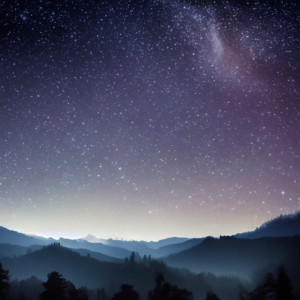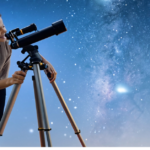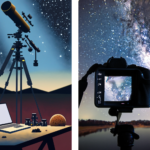Table of Contents
Understanding the influence of weather on Astrophotography is very important and something that seems obvious at first. After all, we all know we need clear skies, don’t we? this why a stargazing weather forecast is most helpful.
Yes, of course, but it is not as simple as I have learned and will continue to learn as I get deeper into astrophotography. In this post, we’ll uncover what types of weather and atmospheric conditions affect astrophotography. We’ll also discuss what you can do to overcome the challenges that certain weather conditions create for us astrophotographers.
Believe me, it is more complicated than you think, and just because the sky looks clear doesn’t mean that your astrophotography images will be unaffected by other aspects of astronomical weather.

Cloud Cover and Its Effects on Night Sky Imaging
Clear skies are ideal for astrophotography as they allow for the best visibility of celestial bodies. This seems fairly obvious, right?
Not so, in my experience! Poor “seeing,” mist, or humidity can ruin what appears to be a clear sky. We’ll look at what “seeing” is later.
Cloud cover can obstruct the view of stars and other celestial bodies, making it difficult to capture clear images.
There are few things more infuriating than setting up, as happened to me recently, having clouds roll in to stop you before you even get started!
Before you polar align your telescope, you need clear conditions, or your camera will not be able to capture those stars that your alignment software needs to gauge where your telescope is pointed in relation to the Polar Axis. No polar alignment, and no imaging session.

Just recently, I had to wait for a half hour or more just to polar align, and I thought about giving up and taking my equipment inside for the night. Then, after going inside and returning after 30 minutes, I saw that the sky had cleared!
The stargazing weather forecast is your friend as it will help you decide when to plan an astrophotography session and when not to. However, there is also always a level of inaccuracy in these forecasts. Your local weather may suddenly change and be quite different from the forecast app you’ve used.
Effects of Temperature and Humidity on Astrophotography
Here are some of the main effects that temperature and humidity have on your equipment:
- High humidity can cause dew to form on the lens of a camera, potentially ruining astrophotography shots.
- Temperature changes can affect the camera sensor’s performance, with cooler temperatures often resulting in less noise in the final image. For every 20°F drop in temperature, digital noise in an image can decrease by up to 50%.
- Extremely cold weather can drain camera batteries faster, affecting the duration of astrophotography sessions.
- Snow and ice can reflect moonlight and other light sources, potentially overexposing the image or washing out faint stars.
- Temperature changes can also alter the focus of your telescope or camera, so this needs to be monitored if you expect a larger swing of temperature at night when you are imaging.
Let’s take a look now at how these stargazing weather effects can influence how we plan for a night’s astrophotography.
Planning Your Astrophotography Shoot: The Stargazing Weather Forecast
To have a trouble-free night of imaging, it’s vital to look at your chosen app and consult your local stargazing weather forecast. Here are the things you need to consider:
- Will it be clear for the whole night or part of the night, and when exactly?
- How strong will the wind be?
- Consider the effect of high cloud because it sometimes appears to be clear but isn’t. This kind of cloud can spoil your images, but sometimes you may be able to image despite some of this light, high cloud.
- Is it going to be misty or humid?
- It’s not weather per se, but the phase of the moon is an important factor in astrophotography. The light from the moon has a negative impact on stargazing conditions. As long as the moon is not too close to your astronomical target and as long as it is not in one of the fuller phases, it may be possible to image successfully. This is a judgement call.
Strategies for Overcoming Weather Challenges in Astrophotography
Where I live, it is often windy. The weather can be very clear, and the only thing that stops me from having a perfect night of astrophotography is the wind. The effect is to cause images to be blurry because gusts move the telescope before the telescope’s auto-guiding system can correct the movement.
However, for short gusts an auto guider can help to adjust your telescope so that any movement is minimized. Here’s what I use:
Wind can also cause camera shake, resulting in blurry images in astrophotography. Wind speeds above 10 mph can cause blurring in long-exposure astrophotography due to the movement of the camera or telescope.
In these windy conditions, I’ve found that shortening my exposure time can fix this problem. Normally, I expose for about six minutes, depending on my target, but in windy conditions, I reduce this to two minutes or even less. The images then become significantly sharper.
An obvious but sometimes difficult-to-implement solution for windy weather is to put my equipment in a sheltered position. This can be a problem, depending on which direction I am pointing my telescope. Building an observatory or viewing area with some shelter from the wind is a good idea.
Stargazing weather forecasts also should consider humidity levels because high humidity can mist optics and cause dew to drip onto lenses and drop inside the tube of the telescope. Many use dew heaters to reduce this problem, especially in the winter months when the weather is colder.
I find that in the climate where I image, the Mediterranean, humidity can be a problem on colder winter nights and also because I am very close to the sea. I use a long cover over the aperture of my scope to stop this, and I don’t normally need to use a dew heater.
As regards the phase of the moon, I have learned to make sure I choose a target not too close to where the moon will be and also to limit my astrophotography to times when the moon is lower in the sky or less than 80% illuminated, but this is only a guide; this may vary. Using a dual-band filter removes much of the moonlight and allows me to photograph my targets even when the moon is relatively bright.
Let’s now look at what you need to do to understand what your stargazing weather forecast is saying to you and whether or not you should go ahead and do astrophotography. Some tools and apps can help, so what do I use? And what else do you need to do to stay ahead of the weather?
Staying Ahead of the Weather: Apps and Tools for the Modern Astrophotographer
Before consulting apps or tools, learn about and monitor the phases of the moon. They are very consistent and follow an ever-repeating pattern. Once you understand the details of the movement and appearance of the moon’s phases, this can help improve your astrophotography.
I use a free app called Clear Outside. The great thing is that it tells me what I need to know about my local stargazing weather forecast and conditions. How much cloud will there be? Will it be, low or high cloud? It also tells me the temperature and wind conditions. Importantly, it tells me the rising and setting times of the moon and its level of illumination on any given night.
This is mostly all I need to know before planning my astrophotography session.
In addition, Clear Outside also tells me what level of light pollution the local area has. It gives this in terms of its Bortle number. See more about light pollution here.
I hope this page has been helpful to you and put you on the path to mastering your stargazing weather forecast so that the weather doesn’t present too many problems for you.








One response
Great article! I completely agree that a stargazing weather forecast is essential for astrophotography. As an astrophotographer myself, I can attest to the fact that clear skies are crucial for capturing beautiful astronomical images. Being able to predict when and where the next clear patch will appear can save time and effort in composition and image processing. Thanks for sharing this useful information!